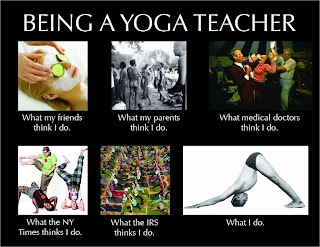I finally saw
The Descendants - a movie about families and love and forgiveness and death. I found the story thoughtful and real and funny. And religious - in the sense that it's about unity. As I note in my essay
Is Yoga a Religion?,
the term “religion” enjoys a similar etymology as yoga. Derived from the Latin word, “religare,” religion means “to bind back” or to reunify.
And here is how I defined yoga at nilambu.com -
B.K.S. Iyengar notes the etymology: “The term yoga is derived from the Sanskrit root yuj meaning to bind, join, attach and yoke, to direct and concentrate one’s attention on, to use and apply.” Iyengar also conveys that in the Bhagavad Gita, Sri Krishna defines yoga as, “a deliverance from contact with pain and sorrow.” Donna Farhi notes, “Yoga is a technology for removing the illusory veil that stands between us and the animating force of life.”
How to we bind back? Join? Attach? Through love and forgiveness. That practice can deliver us from pain and sorrow. It is a practice, none of us are perfect lover and forgivers. For me, that practice inherent on the yogic path and my spiritual practice. And those moments when death enters our lives crystalize the importance of this - how we love and forgive. And helpful to remember why we love and forgive.
Here is the trailer:
And then I saw this article, which is about love, really, and how we define meaning in our lives at the end and how and if God figures into it.
Kerry Egan, a hospice chaplain, and she wrote this thoughtful essay,
My Faith: What People Talk about Before They Die for the CNN religion blog. I was interested too because a dear friend and fellow OM teacher trainee recently shared with me that she is exploring working
What do people who are sick and dying talk about with the chaplain? ...Mostly, they talk about their families: about their mothers and fathers, their sons and daughters. They talk about the love they felt, and the love they gave. Often they talk about love they did not receive, or the love they did not know how to offer, the love they withheld, or maybe felt for the ones they should have loved unconditionally.
They talk about how they learned what love is, and what it is not...people talk to the chaplain about their families because that is who we talk about God. that is how we talk about the meaning of our lives. That is how we talk about the big spiritual questions of human existence.
We don't live in our heads, in theology and theories. We live our lives in our families: the families we are born into, the families we create, the families we make through the people we choose as friends.
And concludes towards the end -
If God is love, and we believe that to be true, that we learn about God when we learn about Love. The first, and usually the last, classroom of love is the family. Sometimes that love is not only imperfect, it seems to be missing entirely.
Monstrous things can happen in families...Even in these cases, I am amazed at the strength of the human soul. People who did not know love in their families know that they should have been loved. They somehow know what was missing, and what they deserved as children and adults.
When love is imperfect, or a family destructive, something else can be learned: forgiveness. The spiritual work of being human is learning how to love and how to forgive.
I agree with that.
If you're looking for a book on forgiveness and Buddhism, check out Jack Kornfield's
The Art of Forgiveness. If you're looking for a book on death and Buddhism, check out the
Lotus in the Fire by Jim Bedard. I've read the latter.
UPDATE: Marianne Williamson tweeted on Thursday February 9: "Think of who you haven't forgiven, then close your eyes and see yourself washing their feet. Hold 2 minutes; you'll be 1,000 times lighter." Love that. We all have someone to forgive in our lives, sometimes ourselves.







